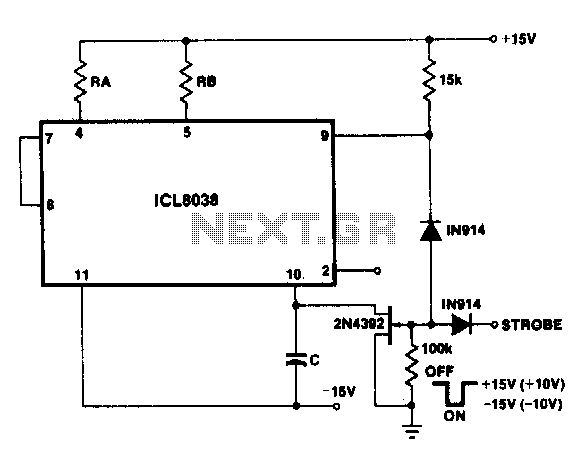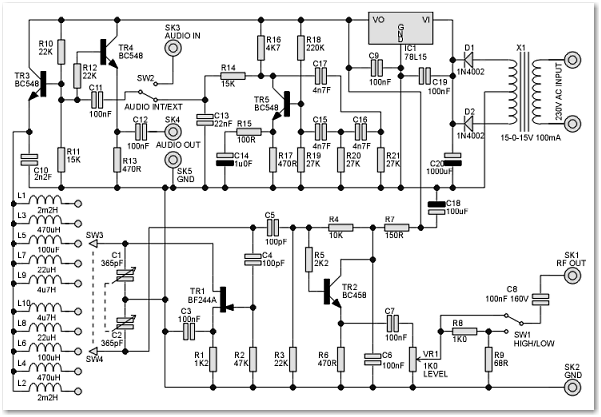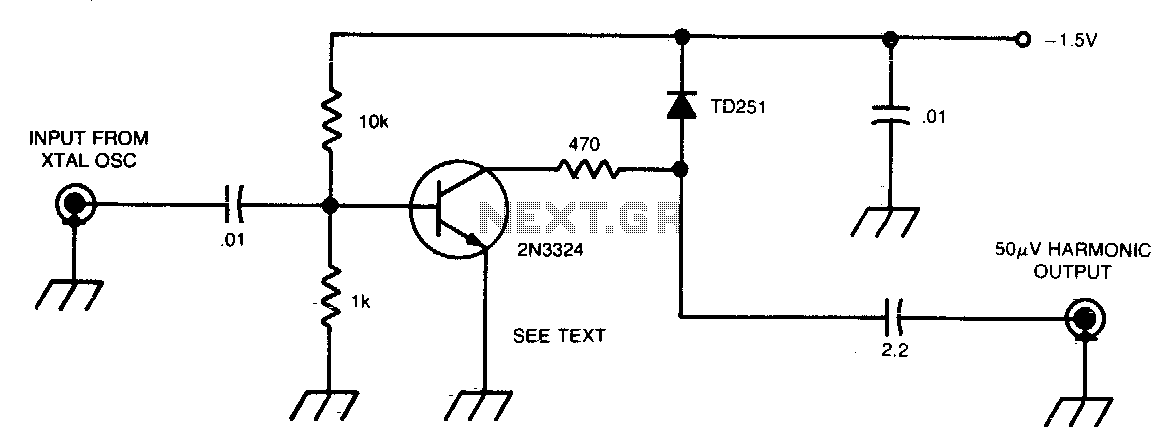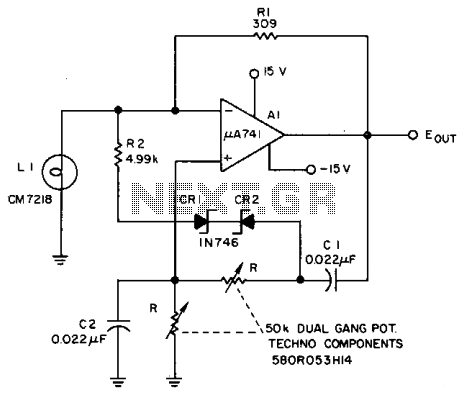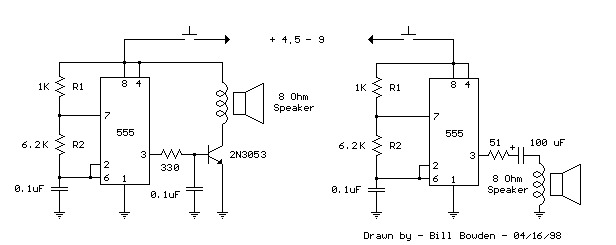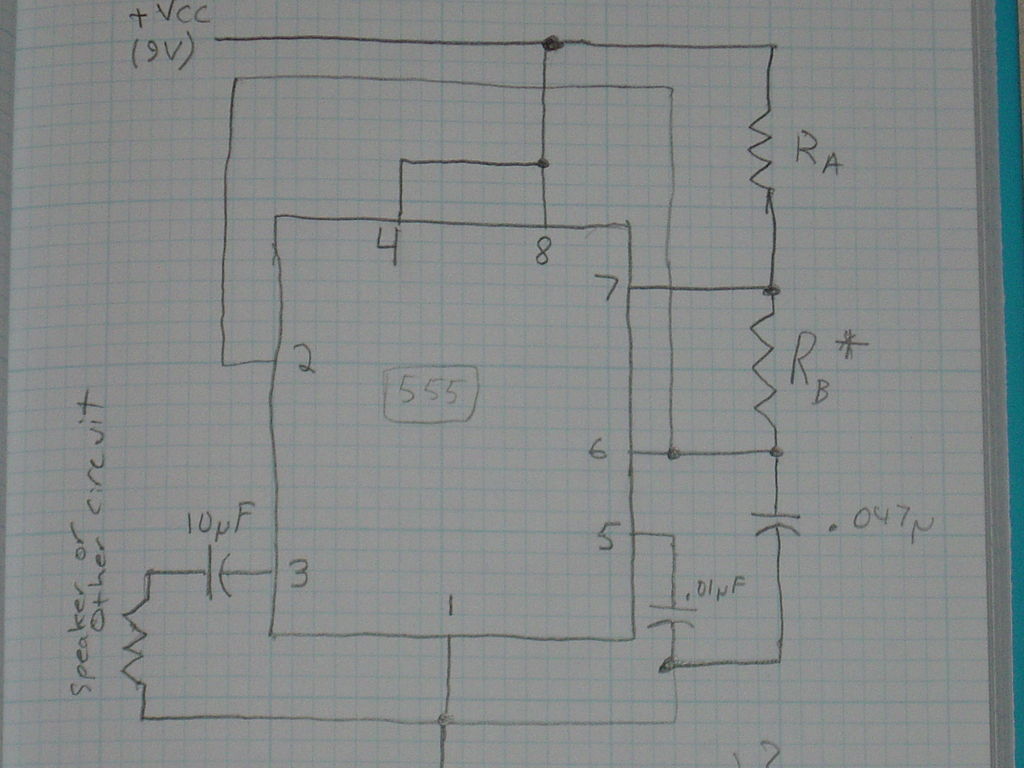
Pure Sine-Wave Generator
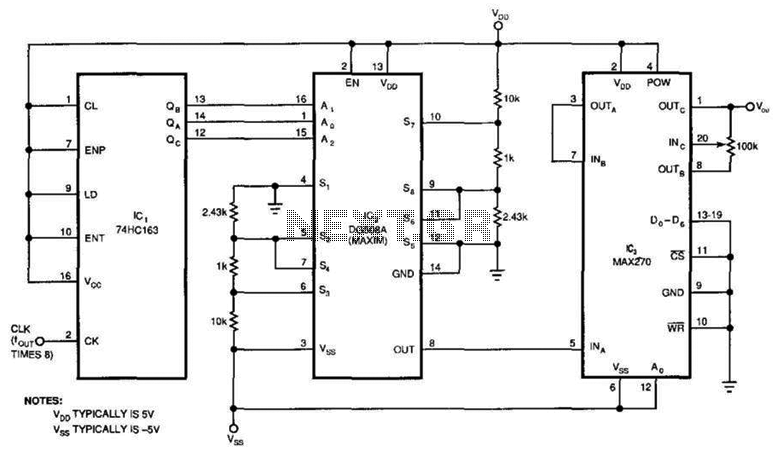
This circuit generates a pure sine wave with a total harmonic distortion (THD) of -80 dB and a frequency equal to the cutoff frequency (fc) of the filter in IC3. It utilizes a counter, an 8-channel analog multiplexer, and a fourth-order low-pass filter to produce sine waves ranging from 1 kHz to 25 kHz, maintaining a THD better than -80 dB. The circuit employs two cascaded second-order, continuous-time Sallen-Key filters within IC3 to form the fourth-order low-pass filter. Bipolar DC inputs for the multiplexer are provided through two resistive dividers connected from ground to VDD and from ground to Vss. To operate the circuit, the cutoff frequency fc must first be selected by connecting the D0 through D6 inputs of IC3 to either 5 V or ground. This allows for 128 different levels of cutoff frequency between 1 kHz and 25 kHz, based on the seven digital input levels. In the current configuration, where D0 through D6 are tied to ground, fc is set to 1 kHz. A 100-kHz potentiometer is used to adjust the output level, which can vary from 1.5 V below VDD to 1.5 V above Vss. The clock input frequency must be eight times higher than the filter's fc. The multiplexer produces an 8x oversampled staircase approximation of a sine wave, which facilitates the low-pass filter's smoothing requirements by shifting the first significant harmonic to seven times the fundamental frequency. All higher-order harmonics are effectively eliminated by IC3, which also includes an uncommitted amplifier for adjusting the output level.
The circuit's architecture is designed to ensure high fidelity in sine wave generation while minimizing distortion. The Sallen-Key topology is particularly effective for implementing the fourth-order low-pass filter, which is critical for attenuating unwanted harmonics and ensuring signal purity. The use of an 8-channel analog multiplexer allows for flexible signal routing, enabling the selection of various input signals based on the configured digital states of D0 through D6.
The choice of using resistive dividers to provide bipolar DC inputs is significant as it allows the multiplexer to handle a range of input levels, which is crucial for applications that require precise control over the output signal. The adjustable output level via the 100-kHz potentiometer provides additional versatility, accommodating different system requirements without the need for additional components.
The requirement for the clock frequency to be eight times the cutoff frequency is a critical design consideration, as it ensures that the output signal is adequately oversampled. This oversampling technique is advantageous because it reduces the complexity of the filtering process, allowing for a more straightforward implementation of the low-pass filter while maintaining the integrity of the desired sine wave output.
Overall, this circuit exemplifies a well-engineered solution for generating high-quality sine waves with minimal distortion, suitable for various applications in signal processing and waveform generation. This circuit produces a pure, - 80-dB THD sine wave with a frequency that is equal to the fc of IC3"s filter. A TT L counter, an 8-channel analog multiplexer, and a fourth-order low-pass filter can generate 1- to 25-kHz sine waves with a THD of better than - 80 dB. The circuit cascades the two second-order, continuous-time Sallen-Key filters within IC3 to implement the fourth-order low-pass filter.
Two resistive dividers connected from ground to VDD and ground to Vss provide bipolar dc inputs to the multiplexer. lb operate the circuit, you first must choose the filter"s cutoff frequency, fc, by tying IC3"s D0 through D6 inputs to 5 V or ground.
The cutoff frequency can be at 128 possible levels between 1 and 25 kHz, depending on those 7 digital input levels. Because this figure ties Z)0 through D6 to ground, fc equals 1 kHz. The 100-kHz potentiometer adjusts the output level anywhere from 1.5 V below Vdd to 1.5 V above Vss-The clock input frequency must be 8 times higher than the filter"s fc.
The multiplexer then produces an 8x oversampled staircase approximation of a sine wave. 8 oversampling greatly simplifies the smoothing requirements of the low-pass filter by pushing the first significant harmonic out to 7 the fundamental. All higher-order harmonics are removed by IC3, which includes an uncommitted amplifier for setting the output level.
🔗 External reference
The circuit's architecture is designed to ensure high fidelity in sine wave generation while minimizing distortion. The Sallen-Key topology is particularly effective for implementing the fourth-order low-pass filter, which is critical for attenuating unwanted harmonics and ensuring signal purity. The use of an 8-channel analog multiplexer allows for flexible signal routing, enabling the selection of various input signals based on the configured digital states of D0 through D6.
The choice of using resistive dividers to provide bipolar DC inputs is significant as it allows the multiplexer to handle a range of input levels, which is crucial for applications that require precise control over the output signal. The adjustable output level via the 100-kHz potentiometer provides additional versatility, accommodating different system requirements without the need for additional components.
The requirement for the clock frequency to be eight times the cutoff frequency is a critical design consideration, as it ensures that the output signal is adequately oversampled. This oversampling technique is advantageous because it reduces the complexity of the filtering process, allowing for a more straightforward implementation of the low-pass filter while maintaining the integrity of the desired sine wave output.
Overall, this circuit exemplifies a well-engineered solution for generating high-quality sine waves with minimal distortion, suitable for various applications in signal processing and waveform generation. This circuit produces a pure, - 80-dB THD sine wave with a frequency that is equal to the fc of IC3"s filter. A TT L counter, an 8-channel analog multiplexer, and a fourth-order low-pass filter can generate 1- to 25-kHz sine waves with a THD of better than - 80 dB. The circuit cascades the two second-order, continuous-time Sallen-Key filters within IC3 to implement the fourth-order low-pass filter.
Two resistive dividers connected from ground to VDD and ground to Vss provide bipolar dc inputs to the multiplexer. lb operate the circuit, you first must choose the filter"s cutoff frequency, fc, by tying IC3"s D0 through D6 inputs to 5 V or ground.
The cutoff frequency can be at 128 possible levels between 1 and 25 kHz, depending on those 7 digital input levels. Because this figure ties Z)0 through D6 to ground, fc equals 1 kHz. The 100-kHz potentiometer adjusts the output level anywhere from 1.5 V below Vdd to 1.5 V above Vss-The clock input frequency must be 8 times higher than the filter"s fc.
The multiplexer then produces an 8x oversampled staircase approximation of a sine wave. 8 oversampling greatly simplifies the smoothing requirements of the low-pass filter by pushing the first significant harmonic out to 7 the fundamental. All higher-order harmonics are removed by IC3, which includes an uncommitted amplifier for setting the output level.
🔗 External reference
